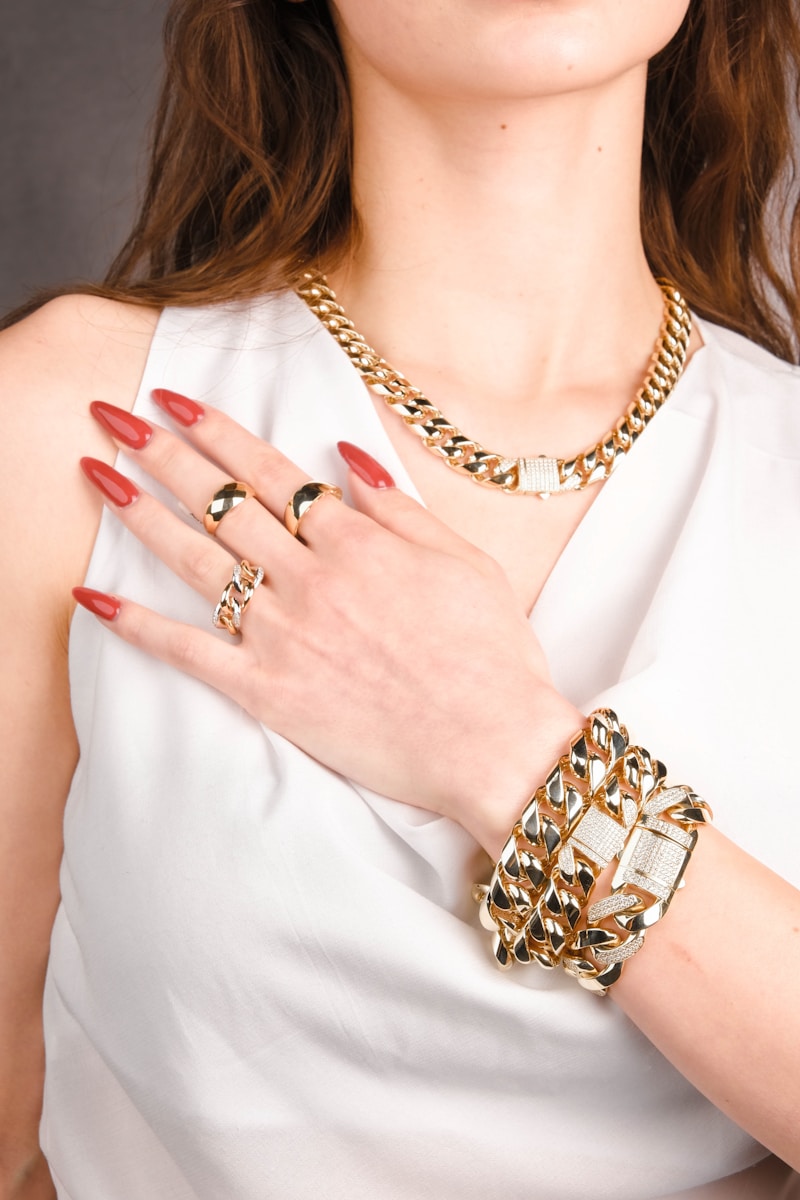Gone are the days when matching metals was a fashion rule. Today, mixing gold, silver, and rose gold has become a modern and versatile jewelry trend. Combining these metals can create a chic and personalized look that elevates any outfit. However, blending different metal tones requires a bit of skill to ensure your pieces complement each other seamlessly. Here’s a guide on how to layer gold, silver, and rose gold to achieve the perfect mix of metals.

1. Start with a Balanced Base
When layering multiple metals, balance is key. Start with a balanced base by selecting one metal as your dominant tone. For example, if you’re more drawn to gold, begin by layering a few gold pieces and then add touches of silver and rose gold to create contrast. Alternatively, silver can serve as the base if you prefer a cooler tone, while rose gold adds a warm, romantic touch. The trick is to ensure no single metal overpowers the others, allowing them to work together in harmony.
2. Stick to Simple, Minimalist Pieces
Layering metals can make a bold statement, so it’s best to stick to simple, minimalist jewelry to avoid an overwhelming look. Delicate chains, thin rings, and sleek bangles are perfect for mixing metals without looking too busy. Minimalist pieces act as a neutral canvas, allowing the mixed metals to shine without clashing or competing for attention. You can always introduce a bolder piece, such as a chunky ring or statement necklace, as the focal point to tie everything together.
3. Vary Lengths and Textures
To create depth and dimension when mixing metals, vary the lengths and textures of your jewelry. For necklaces, try layering pieces of different lengths—such as a choker, mid-length necklace, and a longer pendant—so each piece is visible and distinct. Similarly, mix bracelets with different textures, like a smooth bangle, a braided cuff, or a chain bracelet, to add visual interest. Combining these elements allows the metals to complement each other without blending into a single, flat look.
4. Focus on a Unifying Element
While mixing metals can create a dynamic look, finding a unifying element will keep the ensemble cohesive. For example, choose pieces with similar design elements, such as geometric shapes, minimalistic styles, or stones. A gemstone bracelet, for instance, could incorporate gold, silver, and rose gold in its design, tying the mixed metals together. This helps create a sense of unity while still allowing each metal to stand out individually.
5. Use Mixed Metal Jewelry as Anchors
One of the easiest ways to master the mixed metal trend is to include pieces that already combine multiple metals. Mixed-metal bracelets, rings, or necklaces act as anchors for your layered look and make the transition between gold, silver, and rose gold feel more natural. These pieces help blend the tones effortlessly, creating a cohesive yet layered style that feels intentional rather than random.
6. Don’t Forget About Proportions
When mixing metals, consider the proportions of your jewelry pieces. Mixing a chunky gold bracelet with a thin silver chain may feel unbalanced, so aim to create harmony in the size and scale of the pieces you layer. If you’re wearing a bold gold necklace, balance it out with more delicate silver and rose gold rings or bracelets. This creates a well-thought-out look that maintains the individuality of each piece while working together as a whole.
7. Embrace Asymmetry
Don’t be afraid to embrace asymmetry when layering mixed metals. Wearing mismatched earrings—such as one gold hoop and one silver stud—or stacking different metal rings on each finger can add an unexpected, edgy twist to your look. Asymmetry adds creativity and spontaneity, showcasing your personal style in a fun and non-traditional way.
8. Consider Your Outfit’s Color Palette
Your outfit plays a crucial role in how mixed metals appear. Neutral tones like black, white, beige, and gray provide the perfect backdrop for mixed metal jewelry, allowing the metals to stand out. For a more vibrant outfit, consider how the colors complement or contrast the metals. Cool tones like blue and green pair well with silver, while warmer tones like red and burgundy bring out the warmth in gold and rose gold. A balanced color palette ensures your mixed metals enhance your overall look.
In conclusion, mixing gold, silver, and rose gold is a trend that adds versatility and creativity to your jewelry collection. By starting with a balanced base, layering simple pieces, and playing with lengths, textures, and proportions, you can master the art of combining metals. The result is a stylish and personalized look that works for any occasion—whether it’s a casual day out or a formal evening event.